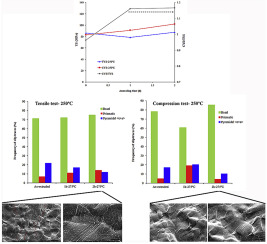当前位置:
X-MOL 学术
›
Acta Mater.
›
论文详情
Our official English website, www.x-mol.net, welcomes your feedback! (Note: you will need to create a separate account there.)
Understanding the high temperature reversed yield asymmetry in a Mg-rare earth alloy by slip trace analysis
Acta Materialia ( IF 9.4 ) Pub Date : 2018-02-01 , DOI: 10.1016/j.actamat.2017.12.021 C.M. Cepeda-Jiménez , C. Prado-Martínez , M.T. Pérez-Prado
Acta Materialia ( IF 9.4 ) Pub Date : 2018-02-01 , DOI: 10.1016/j.actamat.2017.12.021 C.M. Cepeda-Jiménez , C. Prado-Martínez , M.T. Pérez-Prado

|
Abstract In this work electron backscattered diffraction-assisted slip trace analysis was utilized to investigate the origin of the high temperature reversed yield asymmetry in a Mg-rare earth alloy. This material was tested at room and high temperature, in tension and compression, both in the as-extruded condition, in which the alloying elements are in solid solution, as well as following two aging treatments which gave rise to different precipitation levels. A statistically relevant number of slip traces were analyzed after each test in order to estimate the influence of the testing conditions and the precipitation state on the relative activity of basal, prismatic and pyramidal systems. In tension, basal slip was found to be the dominant deformation mechanism under all the testing conditions investigated. In compression, twinning predominated always at room temperature and was replaced by basal slip in the aged samples at high temperature. A pronounced reversed yield asymmetry, i.e., the presence of a higher yield stress in compression than in tension, was observed at high temperature in the aged alloy samples. Careful microstructural examination of the spatial distribution of slip traces by high resolution scanning electron microscopy (SEM) revealed increased intra- and intergranular basal slip localization in those specimens under tensile deformation at high temperature. The high temperature reversed yield asymmetry observed in the aged samples was thus attributed to the suppression of twinning in compression and to enhanced softening in tension due to basal slip localization.
中文翻译:

通过滑移痕量分析了解镁稀土合金的高温反向屈服不对称性
摘要 在这项工作中,电子背散射衍射辅助滑移痕量分析被用来研究镁稀土合金中高温反向屈服不对称的起源。该材料在室温和高温下进行拉伸和压缩测试,在挤压状态下,其中合金元素处于固溶体,以及经过两次时效处理,这会产生不同的沉淀水平。在每次测试后分析统计相关数量的滑动痕迹,以估计测试条件和降水状态对基础、棱柱和金字塔系统的相对活动的影响。在拉伸中,在所有研究的测试条件下,发现基底滑移是主要的变形机制。在压缩中,孪生总是在室温下占主导地位,并在高温老化样品中被基底滑移所取代。在高温时效合金样品中观察到明显的反向屈服不对称,即压缩时的屈服应力高于拉伸时的屈服应力。通过高分辨率扫描电子显微镜 (SEM) 对滑移痕迹空间分布的仔细微观结构检查显示,在高温拉伸变形下,这些试样的晶内和晶间基底滑移定位增加。因此,在老化样品中观察到的高温反向屈服不对称性归因于压缩孪晶的抑制和由于基底滑移局部化导致的拉伸软化增强。
更新日期:2018-02-01
中文翻译:

通过滑移痕量分析了解镁稀土合金的高温反向屈服不对称性
摘要 在这项工作中,电子背散射衍射辅助滑移痕量分析被用来研究镁稀土合金中高温反向屈服不对称的起源。该材料在室温和高温下进行拉伸和压缩测试,在挤压状态下,其中合金元素处于固溶体,以及经过两次时效处理,这会产生不同的沉淀水平。在每次测试后分析统计相关数量的滑动痕迹,以估计测试条件和降水状态对基础、棱柱和金字塔系统的相对活动的影响。在拉伸中,在所有研究的测试条件下,发现基底滑移是主要的变形机制。在压缩中,孪生总是在室温下占主导地位,并在高温老化样品中被基底滑移所取代。在高温时效合金样品中观察到明显的反向屈服不对称,即压缩时的屈服应力高于拉伸时的屈服应力。通过高分辨率扫描电子显微镜 (SEM) 对滑移痕迹空间分布的仔细微观结构检查显示,在高温拉伸变形下,这些试样的晶内和晶间基底滑移定位增加。因此,在老化样品中观察到的高温反向屈服不对称性归因于压缩孪晶的抑制和由于基底滑移局部化导致的拉伸软化增强。



























 京公网安备 11010802027423号
京公网安备 11010802027423号